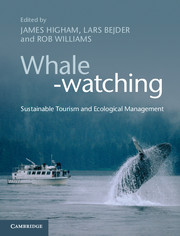Book contents
- Frontmatter
- Dedication
- Contents
- Acknowledgements
- List of contributors
- List of abbreviations
- 1 Tourism, cetaceans and sustainable development
- Part I The historical and contemporary contexts
- Part II Human dimensions of whale-watching
- Part III Ecological dimensions of whale-watching
- 13 Understanding the ecological effects of whale-watching on cetaceans
- 14 Whale-watching and behavioural ecology
- 15 Energetic linkages between short-term and long-term effects of whale-watching disturbance on cetaceans
- 16 Ecological constraints and the propensity for population consequences of whale-watching disturbances
- 17 The use of area–time closures as a tool to manage cetacean-watch tourism
- Part IV Sustainable management: insights and issues
- Index
- Plate Section
- References
15 - Energetic linkages between short-term and long-term effects of whale-watching disturbance on cetaceans
An example drawn from northeast Pacific resident killer whales
from Part III - Ecological dimensions of whale-watching
Published online by Cambridge University Press: 05 April 2014
- Frontmatter
- Dedication
- Contents
- Acknowledgements
- List of contributors
- List of abbreviations
- 1 Tourism, cetaceans and sustainable development
- Part I The historical and contemporary contexts
- Part II Human dimensions of whale-watching
- Part III Ecological dimensions of whale-watching
- 13 Understanding the ecological effects of whale-watching on cetaceans
- 14 Whale-watching and behavioural ecology
- 15 Energetic linkages between short-term and long-term effects of whale-watching disturbance on cetaceans
- 16 Ecological constraints and the propensity for population consequences of whale-watching disturbances
- 17 The use of area–time closures as a tool to manage cetacean-watch tourism
- Part IV Sustainable management: insights and issues
- Index
- Plate Section
- References
Summary
Introduction
Many studies have demonstrated short-term behavioural responses by whales and dolphins in the presence of vessels, but the population-level implications of such changes are poorly understood (Lusseau, 2003, 2004; Bejder et al., 2006a; Lusseau & Bejder, 2007). One means for developing such an understanding is to use a modelling framework such as the Population Consequences of Acoustic Disturbance (PCAD) model. PCAD identifies four levels at which data can be collected, and allows for estimates of modelling parameters at one level to be based on measured data at another level (National Research Council, 2005).
The first level contains short-term behavioural responses, such as those that have been the typical focus of studies on effects of whale-watching. Effects vary within and between species, and include changes in respiration patterns, surface active behaviours, swimming velocity, vocal behaviour, activity state, inter-individual spacing, wake riding, approach and avoidance, and displacement from habitat. Collisions may result in injury or death (Wells & Scott, 1997; Laist et al., 2001). More detailed reviews of vessel effects can be found in Lien (2001) and Ritter (2003).
- Type
- Chapter
- Information
- Whale-watchingSustainable Tourism and Ecological Management, pp. 206 - 228Publisher: Cambridge University PressPrint publication year: 2014
References
- 3
- Cited by



